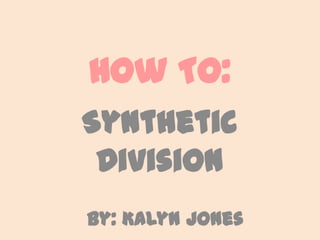More Related Content
What's hot
What's hot (20)
SIM for Mathematics; Addition and Subtraction of Rational Numbers

SIM for Mathematics; Addition and Subtraction of Rational Numbers
Similar to Bingo
Similar to Bingo (20)
Bingo
- 1. How To: Synthetic Division By: Kalyn Jones
- 2. Step One: Write down the coefficients of each term Which are the numbers in the equation. Ex: (2x-7) / (x=3) 2 and 7 would be the coefficients.
- 3. Step two: Draw a box and a line. Then, take the opposite sign of what you’re dividing by. In this example the boxed in number would of originally been a negative, but you always switch the sign. The box goes around the number you are using to divide with and the line is to simply separate the old problem from the new answer.
- 4. Step three: Bring down the first term Once again, using this example. The first term would be 3, because it is simply the first number in the equation. You drop it straight down and move on to the other numbers.
- 5. Step Four: Multiply and Add- Repeat For example: 3 x 4 = 12 0-12 = -12 -12 x 4 = -38 -38-48 = 10 Etc. 719 would be a remainder.
